中考英语句型翻译——状语从句
- 格式:docx
- 大小:18.60 KB
- 文档页数:8
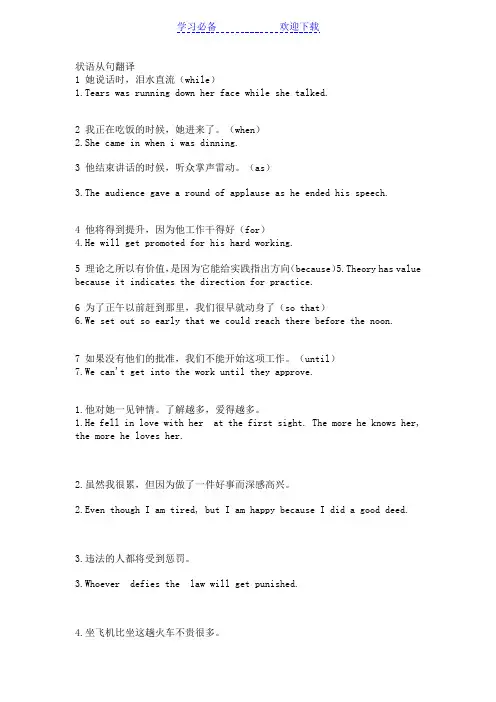
状语从句翻译1 她说话时,泪水直流(while)1.Tears was running down her face while she talked.2 我正在吃饭的时候,她进来了。
(when)2.She came in when i was dinning.3 他结束讲话的时候,听众掌声雷动。
(as)3.The audience gave a round of applause as he ended his speech.4 他将得到提升,因为他工作干得好(for)4.He will get promoted for his hard working.5 理论之所以有价值,是因为它能给实践指出方向(because)5.Theory has value because it indicates the direction for practice.6 为了正午以前赶到那里,我们很早就动身了(so that)6.We set out so early that we could reach there before the noon.7 如果没有他们的批准,我们不能开始这项工作。
(until)7.We can't get into the work until they approve.1.他对她一见钟情。
了解越多,爱得越多。
1.He fell in love with her at the first sight. The more he knows her, the more he loves her.2.虽然我很累,但因为做了一件好事而深感高兴。
2.Even though I am tired, but I am happy because I did a good deed.3.违法的人都将受到惩罚。
3.Whoever defies the law will get punished.4.坐飞机比坐这趟火车不贵很多。
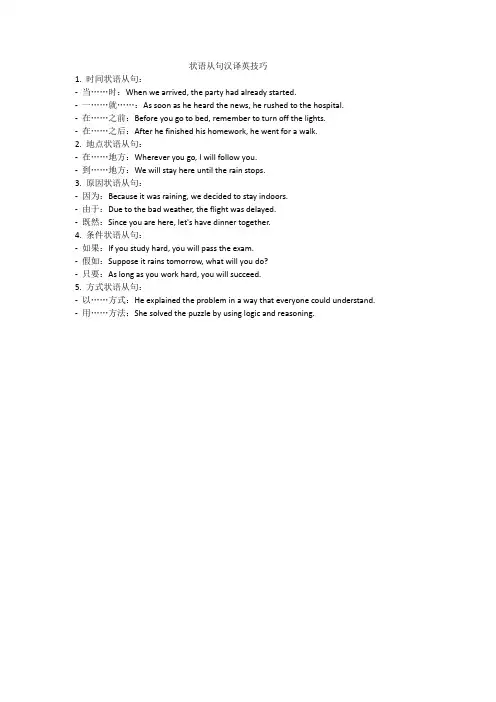
状语从句汉译英技巧1. 时间状语从句:-当……时:When we arrived, the party had already started.-一……就……:As soon as he heard the news, he rushed to the hospital.-在……之前:Before you go to bed, remember to turn off the lights.-在……之后:After he finished his homework, he went for a walk.2. 地点状语从句:-在……地方:Wherever you go, I will follow you.-到……地方:We will stay here until the rain stops.3. 原因状语从句:-因为:Because it was raining, we decided to stay indoors.-由于:Due to the bad weather, the flight was delayed.-既然:Since you are here, let's have dinner together.4. 条件状语从句:-如果:If you study hard, you will pass the exam.-假如:Suppose it rains tomorrow, what will you do?-只要:As long as you work hard, you will succeed.5. 方式状语从句:-以……方式:He explained the problem in a way that everyone could understand. -用……方法:She solved the puzzle by using logic and reasoning.。

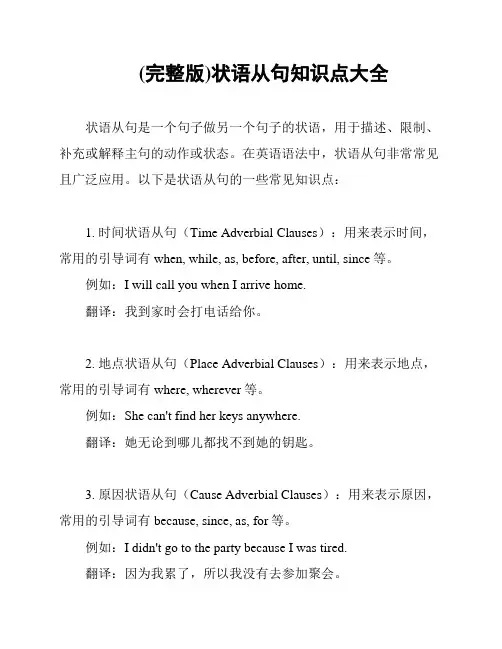
(完整版)状语从句知识点大全状语从句是一个句子做另一个句子的状语,用于描述、限制、补充或解释主句的动作或状态。
在英语语法中,状语从句非常常见且广泛应用。
以下是状语从句的一些常见知识点:1. 时间状语从句(Time Adverbial Clauses):用来表示时间,常用的引导词有when, while, as, before, after, until, since等。
例如:I will call you when I arrive home.翻译:我到家时会打电话给你。
2. 地点状语从句(Place Adverbial Clauses):用来表示地点,常用的引导词有where, wherever等。
例如:She can't find her keys anywhere.翻译:她无论到哪儿都找不到她的钥匙。
3. 原因状语从句(Cause Adverbial Clauses):用来表示原因,常用的引导词有because, since, as, for等。
例如:I didn't go to the party because I was tired.翻译:因为我累了,所以我没有去参加聚会。
4. 结果状语从句(Result Adverbial Clauses):用来表示结果,常用的引导词有so, therefore, thus等。
例如:He studied hard, so he passed the exam.翻译:他努力研究,所以他通过了考试。
5. 条件状语从句(Condition Adverbial Clauses):用来表示条件,常用的引导词有if, unless, provided that等。
例如:If it rains tomorrow, we won't go to the park.翻译:如果明天下雨,我们不会去公园。
6. 目的状语从句(Purpose Adverbial Clauses):用来表示目的,常用的引导词有so that, in order that等。
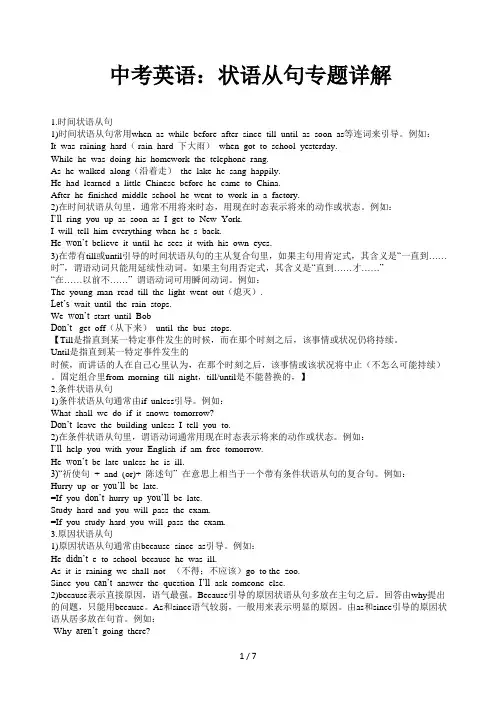
中考英语:状语从句专题详解1.时间状语从句1)时间状语从句常用when as while before after since till until as soon as等连词来引导。
例如:It was raining hard( rain hard 下大雨)when got to school yesterday.While he was doing his homework the telephone rang.As he walked along(沿着走)the lake he sang happily.He had learned a little Chinese before he came to China.After he finished middle school he went to work in a factory.2)在时间状语从句里,通常不用将来时态,用现在时态表示将来的动作或状态。
例如:I’ll ring you up as soon as I get to New York.I will tell him everything when he s back.He won’t believe it until he sees it with his own eyes.3)在带有till或until引导的时间状语从句的主从复合句里,如果主句用肯定式,其含义是“一直到……时”,谓语动词只能用延续性动词。
如果主句用否定式,其含义是“直到……才……”“在……以前不……”谓语动词可用瞬间动词。
例如:The young man read till the light went out(熄灭).Let’s wait until the rain stops.We won’t start until BobDon’t get off(从下来)until the bus stops.【Till是指直到某一特定事件发生的时候,而在那个时刻之后,该事情或状况仍将持续。
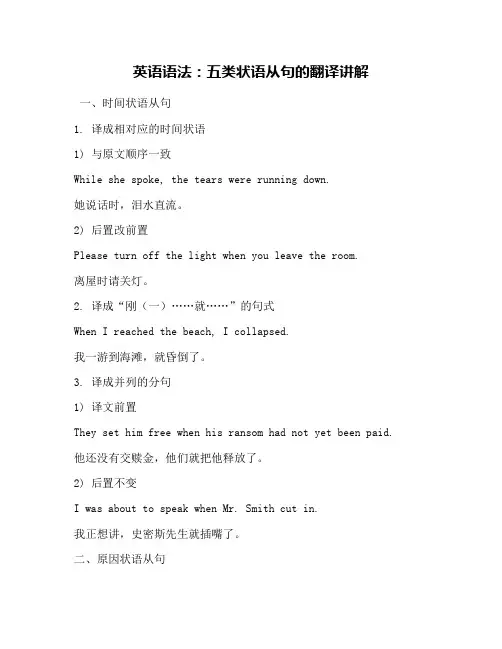
英语语法:五类状语从句的翻译讲解一、时间状语从句1. 译成相对应的时间状语1) 与原文顺序一致While she spoke, the tears were running down.她说话时,泪水直流。
2) 后置改前置Please turn off the light when you leave the room.离屋时请关灯。
2. 译成“刚(一)……就……”的句式When I reached the beach, I collapsed.我一游到海滩,就昏倒了。
3. 译成并列的分句1) 译文前置They set him free when his ransom had not yet been paid.他还没有交赎金,他们就把他释放了。
2) 后置不变I was about to speak when Mr. Smith cut in.我正想讲,史密斯先生就插嘴了。
二、原因状语从句1. 译成表“因”的分句1) “因”在“果”之前The crops failed because the season was dry.因为气候干旱,作物歉收。
2) “果”在“因”之前She could get away with anything, because she looked such a baby.她能渡过任何风险,因为她看上去简直还像娃娃模样。
2. 译成因果偏正复句中的主句Pure iron is not used in industry because it is too soft.纯铁太软,所以不用在工业上。
Because he was convinced of the accuracy of this fact, he stuck to his opinion.他深信这件事准确可靠,所以坚持己见。
3. 译成无关联词的因果关系并列分句Where there is sound, there must be sound waves.哪里有声音,哪里就必有声波。
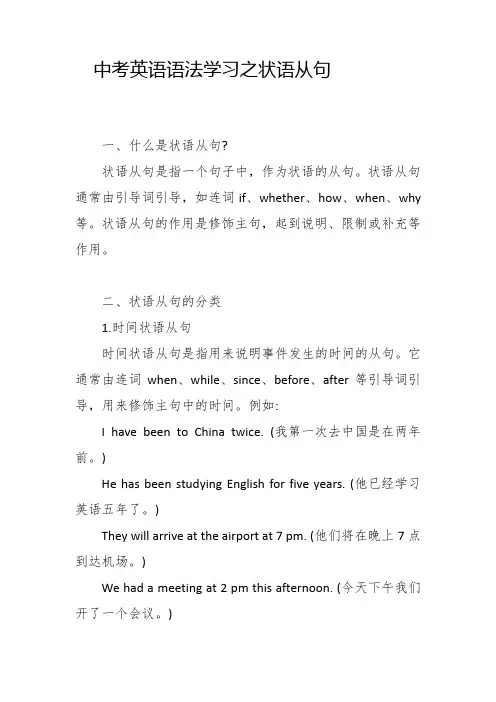
中考英语语法学习之状语从句一、什么是状语从句?状语从句是指一个句子中,作为状语的从句。
状语从句通常由引导词引导,如连词if、whether、how、when、why 等。
状语从句的作用是修饰主句,起到说明、限制或补充等作用。
二、状语从句的分类1.时间状语从句时间状语从句是指用来说明事件发生的时间的从句。
它通常由连词when、while、since、before、after等引导词引导,用来修饰主句中的时间。
例如:I have been to China twice. (我第一次去中国是在两年前。
)He has been studying English for five years. (他已经学习英语五年了。
)They will arrive at the airport at 7 pm. (他们将在晚上7点到达机场。
)We had a meeting at 2 pm this afternoon. (今天下午我们开了一个会议。
)需要注意的是,时间状语从句通常放在主句之前或之后,但在某些情况下可能会放在主句中间。
2.地点状语从句地点状语从句是指用来说明事件发生的地点的从句。
它通常由连词where、why、how等引导词引导,用来修饰主句中的地点。
例如:I saw her in the library. (我在图书馆看到她。
)They are going to have a meeting in the conference room. (他们将在会议室里开会。
)He is studying in his bedroom. (他正在卧室里学习。
)We had dinner at a restaurant last night. (昨晚我们在一家餐厅吃了晚饭。
)需要注意的是,地点状语从句通常放在主句之前或之后,但在某些情况下可能会放在主句中间。
3.原因状语从句原因状语从句是指用来说明事件发生的原因的从句。

1.We would like your attention for three minutes while we explain the safety guidefor this flight.时间状从请大家用三分钟时间注意听讲,在我们解释这次航班的安全指南时。
*请大家用三分钟注意听讲一下这次航班的安全指南。
2.While we are serving meals, please move your seat back to its right place forsafety of the passenger behind you. 时间状从供应餐饮期间,为了你身后乘客的安全请大家将座椅移回原位。
3.If you need any help, please let us know by switching on the button next to thelight above your head. 条件状从如需帮助,请按你头顶上方靠灯的按钮让我们知道。
4.One of the most exciting moments will be in May when the Olympic flame istaken to the highest peak(山峰)in the world--Monut Qomolangma. 时间状从最令人兴奋的时刻之一将在五月,那时奥运火炬将被带到世界之巅--珠穆朗玛峰。
5.Ella and Hebe entered simply for the 10,000 yuan prize, while Selina wasencouraged by her young sister, who was then too young to take part. 转折对比,非限定性定从E和H的参赛只是奔着10000元的奖金而来的,而S的参赛却是受到了妹妹的鼓动,她妹妹那是还小,不能参赛。
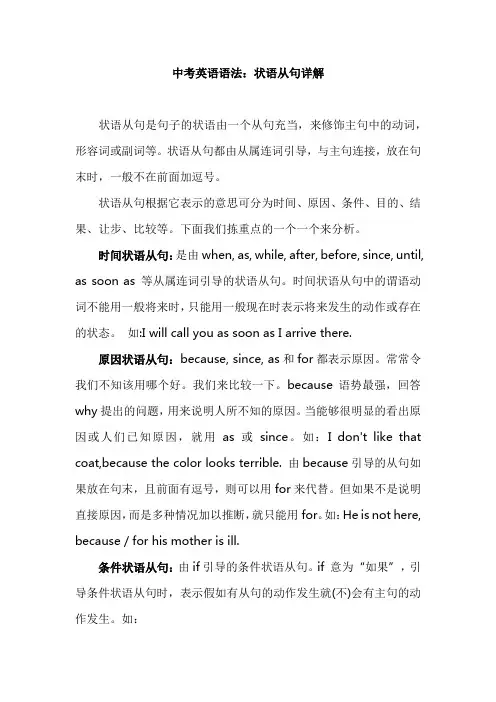
中考英语语法:状语从句详解状语从句是句子的状语由一个从句充当,来修饰主句中的动词,形容词或副词等。
状语从句都由从属连词引导,与主句连接,放在句末时,一般不在前面加逗号。
状语从句根据它表示的意思可分为时间、原因、条件、目的、结果、让步、比较等。
下面我们拣重点的一个一个来分析。
时间状语从句:是由when, as, while, after, before, since, until, as soon as 等从属连词引导的状语从句。
时间状语从句中的谓语动词不能用一般将来时,只能用一般现在时表示将来发生的动作或存在的状态。
如:I will call you as soon as I arrive there.原因状语从句:because, since, as和for都表示原因。
常常令我们不知该用哪个好。
我们来比较一下。
because语势最强,回答why提出的问题,用来说明人所不知的原因。
当能够很明显的看出原因或人们已知原因,就用as或since。
如:I don't like that coat,because the color looks terrible. 由because引导的从句如果放在句末,且前面有逗号,则可以用for来代替。
但如果不是说明直接原因,而是多种情况加以推断,就只能用for。
如:He is not here, because / for his mother is ill.条件状语从句:由if引导的条件状语从句。
if 意为“如果”,引导条件状语从句时,表示假如有从句的动作发生就(不)会有主句的动作发生。
如:If it doesn't rain tomorrow, we will go there by bike. 如果明天不下雨,我们就骑自行车去那里。
If I get there early, I can see the doctor quickly. 如果我早早地到那里,我就可以快点看病。
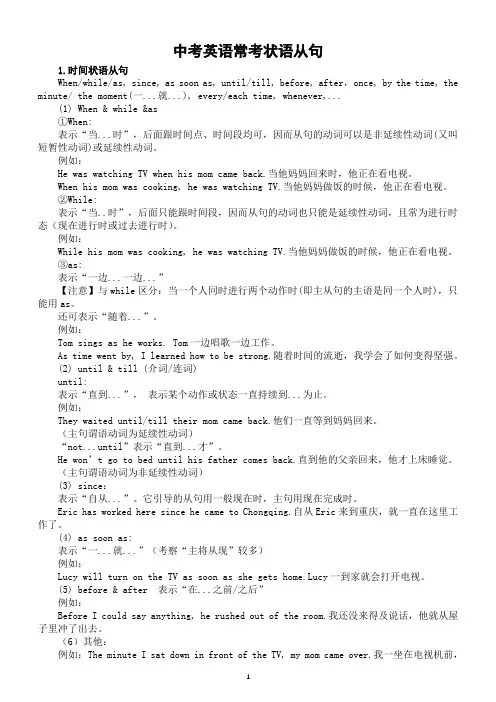
中考英语常考状语从句1.时间状语从句When/while/as, since, as soon as, until/till, before, after,once, by the time, the minute/ the moment(一...就...), every/each time, whenever,...(1) When & while &as①When:表示“当...时”,后面跟时间点、时间段均可,因而从句的动词可以是非延续性动词(又叫短暂性动词)或延续性动词。
例如:He was watching TV when his mom came back.当他妈妈回来时,他正在看电视。
When his mom was cooking, he was watching TV.当他妈妈做饭的时候,他正在看电视。
②While:表示“当..时”,后面只能跟时间段,因而从句的动词也只能是延续性动词,且常为进行时态(现在进行时或过去进行时)。
例如:While his mom was cooking, he was watching TV.当他妈妈做饭的时候,他正在看电视。
③as:表示“一边...一边...”【注意】与while区分:当一个人同时进行两个动作时(即主从句的主语是同一个人时),只能用as。
还可表示“随着...”。
例如:Tom sings as he works. Tom一边唱歌一边工作。
As time went by, I learned how to be strong.随着时间的流逝,我学会了如何变得坚强。
(2) until & till (介词/连词)until:表示“直到...”,表示某个动作或状态一直持续到...为止。
例如:They waited until/till their mom came back.他们一直等到妈妈回来。
(主句谓语动词为延续性动词)“not...until”表示“直到...才”。

状语从句内容丰富,涉及面广,可以用来表示时间、原因、条件、让步、目的、结果、等意义。
英语状语从句的翻译,一般比较容易处理,通常可以直接翻译。
但是这里我们所要讨论的是,在汉语译文中,要如何将状语从句置于恰当的位置,并如何将其与主句之间自然连贯地连接起来,如何按汉语的习惯表达将句子类型进行相应的变化。
由于两种语言表达上的不同,在状语从句的安排方面,存在着明显的差异,所以在翻译的时候也需要根据汉语习惯来灵活翻译。
一、时间状语从句(一)译成相应的时间状语她说话时,泪水直流。
我正在吃饭的时候,她进来了。
他结束讲话的时候,听众掌声雷动。
(二)译成“一(刚、每)……就”的结构我一安排好就通知你。
他刚说出这些话,大家就沉默下来。
(三)译成条件句由于时间状语的引导词除了显示时间关系之外,有时候可以表示条件关系,所以还可以翻译为条件句。
如果机器发生故障,就把电门关上。
若无外力的作用,静止的物体不会移动。
如果没有有关当局的批准,我们不能开始这项工作。
二、原因状语从句(一)译成表示“原因”的分句,放在主句之前翻译,显示“前因后果”的关系。
因为气候干旱,作物歉收。
由于很多人没有来,会议只好延期。
(二)原因状语从句在汉语中的位置,常常是“前因后果”。
然而,英语则比较灵活,状语从句可以在主句前,也可以在主句后面。
所以在翻译为汉语译文时,也有放在后面的。
如果把原因状语从句放在主句后面翻译的话,有时候可以用汉语的“之所以……是因为”的结构来连接。
a gas differs from solid in that it has no definite shape.气体不同于固体是因为(就在于)它没有固定的形状。
他将得到提升,因为他工作干得好。
理论之所以有价值,是因为它能给实践指出方向。
我之所以教书并不是因为教书对我来说太容易机器停了下来,并不是因为燃料耗尽了.三、条件状语从句(一)翻译在主句前面。
要是把他们捉到了,那就更好了。
假如你把一切都告诉我,那么我就能够作出决定。
名师指导:状语从句的翻译英语状语从句表示时间、原因、条件、让步、目的等等, 英语状语从句用在主句后面的较多, 而汉语的状语从句用在主句前的较多, 因此, 在许多情况下,将状语从句放在主句前面。
下面我们通过一些实例说明它们常用的翻译方法。
例1. When the levels reached 6 percent the crew members would become mentally confused, unable to take measures to preserve their lives.简析:take measures to:采取措施。
由when引导时间状语。
译文:当含量达到6%时, 飞船上的人员将会神经错乱, 无法采取保护自己生命的措施。
例2. When censorship laws are relaxed, dishonest people are given a chance to produce virtually anything in the name of “art”.简析:in the name of:以……的名义。
仍是由when引导的时间状语。
译文:当审查放宽时, 招摇撞骗之徒就会有机可乘, 在“艺术”的幌子下炮制出形形色色的东西来。
例3. Now since the assessment of intelligence is a comparative matter we must be sure that the scale with which we are comparing our subjects provides a 'valid' or 'fair' comparison.简析:由since,引导的原因状语从句。
译文:既然对智力的评估是比较而言的, 那么我们必须确保, 在对我们的对象进行比较时, 我们所使用的尺度能提供“有效的”或“公平的”比较。
中考英语语法之状语从句状语从句在中考英语语法中占据重要的地位。
状语从句在句子中充当状语,用来修饰动词、形容词、副词等,对于句子的意义和表达起到了关键作用。
本文将介绍状语从句的概念、分类以及使用方法,帮助同学们更好地掌握中考英语语法中的状语从句。
一、状语从句的概念状语从句是一个从句,它修饰整个主句中的一个词,常常由连词引导,如when, while, if, because等。
状语从句用来表达时间、条件、原因、方式等多种语义概念。
二、状语从句的分类状语从句按照引导词的不同可以分为时间状语从句、条件状语从句、原因状语从句、结果状语从句和方式状语从句。
1. 时间状语从句时间状语从句用来表达一个动作或者状态发生的时间,在主句之前或者之后。
常见的引导词有when, while, before, after等。
例如:- I will visit my grandparents when I have time.- She fell asleep while she was watching TV.2. 条件状语从句条件状语从句用来表达主句动作的条件,常见的引导词有if, unless 等。
例如:- If it rains tomorrow, we will stay at home.- I will not go to the party unless you invite me.3. 原因状语从句原因状语从句用来表达主句发生的原因,常见的引导词有because, since, as等。
例如:- I couldn't finish my homework because I was too tired.- Since it's raining heavily, we should bring an umbrella.4. 结果状语从句结果状语从句用来表达主句动作的结果,常见的引导词有so that, such...that等。
初中英语九种状语从句归纳总结一、时间状语从句(Time adverbial clauses)时间状语从句用来表示一个动作或事件发生的时间。
常见的引导词有:when(当…时候)、while(当…的时候)、as(当…时候)、before (在…之前)、after(在…之后)、since(自从…以来)、until(直到…为止)、as soon as(一…就…)、whenever(无论何时)等等。
例如:- She likes to listen to music while she is cooking.(她喜欢一边做饭一边听音乐。
)- He went to bed after he finished his homework.(他做完作业后去睡觉了。
)二、地点状语从句(Place adverbial clauses)地点状语从句用来表示一个动作或事件发生的地点。
常见的引导词有:where(在哪里)、wherever(无论在哪里)等等。
例如:- I will meet you at the place where we first met.(我会在我们第一次见面的地方见你。
)三、方式状语从句(Manner adverbial clauses)方式状语从句用来表示一个动作或事件发生的方式。
常见的引导词有:as(以…方式)、as if(好像)、as though(好像)等等。
例如:- She sang the song as if she was performing on stage.(她唱歌的时候好像在舞台上表演一样。
)- He spoke English as though he was a native speaker.(他讲英语好像是母语一样。
)四、原因状语从句(Reason adverbial clauses)原因状语从句用来表示一个动作或事件发生的原因。
常见的引导词有:because(因为)、as(因为)、since(因为)、as long as(只要)等等。
状语从句一.状语的存在是为结构已经完整的句子添补信息,用来说明动发生的时间、地点、方式等,一般用单词或短语作状语。
例子:I go to school.(主谓宾都有,结构完整)I go to school every day.(增添了表明时间的状语)I go to school by bus.(增添了表明方式的状语。
)二.从句:处于从属地位的句子三.状语从句的本质:当给出的状语信息越来越丰富,无法仅用一个单词或逗语来表达时,就可以用一个句子来充当状语成分例子:I went to school.(我去上学。
)I went to school when I was four years old.(状语从句)(我四岁的时候就去上学了。
)②状语从句的两类结构:(1)引导词十从句,主句→Because this book is interesting,I like it.(1)主句十引导词十从句→I like this book because it's interesting四.状语从句的分类(一)时间状语从句※引导词:when(在…时),while(在…期间),as(随着),before(在…之前),after(在…之后),since(自从),till/until(直到),not…until(直到…才),as soon as(一…就)等。
When Igot off the bus,I fell down.(当我下车时,我捽倒了。
)(时间点)I was doing my homework while my mum was cooking.(当我妈妈在做饭时,我在写作业。
)(时间段-表两个动作同时进行)Things will get easier as time goes by.(两个动作同时发生。
)(随着时间的流逝,情况会有所改善。
)②till/until与not…until区别till/until→表延续性动作的结束,跟其连用的一般为延续性动词。
中考英语句型翻译——状语从句状语从句内容丰富,涉及面广,可以用来表示时间、原因、条件、让步、目的、结果、等意义。
英语状语从句的翻译,一般比较容易处理,通常可以直接翻译。
但是这里我们所要讨论的是,在汉语译文中,要如何将状语从句置于恰当的位置,并如何将其与主句之间自然连贯地连接起来,如何按汉语的习惯表达将句子类型进行相应的变化。
由于两种语言表达上的不同,在状语从句的安排方面,存在着明显的差异,所以在翻译的时候也需要根据汉语习惯来灵活翻译。
一、时间状语从句在英语中,时间状语从句的连接词常常有:when(当……的时候),whenever(每当……),as(当……时),since(自从……),until(直到……,如果不……),till(直到……),before(在……前),after(在……后),assoonas(一……就),once(一旦……),themoment(一……就),immediately (一……就),theday(在……那天),nosooner……than (一……就),hardly(scarcely)……when(一……就),theinstant(一……就),instantly(一……就),directly (一……就),theminute(一……就),thesecond(一……就),everytime(每当……),bythetime(等到……的时候)等。
翻译的时候,一般翻译在主句的前面。
(一)译成相应的时间状语whileshespoke,thetearswererunningdown.她说话时,泪水直流。
ShecameinwhenIwashavingsupper.我正在吃饭的时候,她进来了。
Ashefinishedthespeech,theaudienceburstintoapplause.他结束讲话的时候,听众掌声雷动。
(二)译成“一(刚、每)……就”的结构I’llletyouknowassoonasIhaveitarranged.我一安排好就通知你。
Directlyheutteredthesewordstherewasadeadsilence.他刚说出这些话,大家就沉默下来。
(三)译成条件句由于时间状语的引导词除了显示时间关系之外,有时候可以表示条件关系,所以还可以翻译为条件句。
Turnofftheswitchwhenanythinggoeswrongwiththemachine.如果机器发生故障,就把电门关上。
Abodyatrestwillnotmovetillaforceisexertedonit.若无外力的作用,静止的物体不会移动。
wecan'tstartthejobuntilwehavetheapprovalfromtheauth orityconcerned.如果没有有关当局的批准,我们不能开始这项工作。
二、原因状语从句英语中,原因状语从句的连接词常常是:because(因为),since(既然,由于),as(因为),nowthat(既然),seeingthat(既然),consideringthat(考虑到,因为),inthat(在某方面),inviewofthefactthat(鉴于)。
在翻译的时候,大多数原因状语从句可以放在主句之前翻译。
(一)译成表示“原因”的分句,放在主句之前翻译,显示“前因后果”的关系。
Thecropsfailedbecausetheseasonwasdry.因为气候干旱,作物歉收。
wehadtoputthemeetingoff,sincesomanypeoplewereabsent.由于很多人没有来,会议只好延期。
(二)原因状语从句在汉语中的位置,常常是“前因后果”。
然而,英语则比较灵活,状语从句可以在主句前,也可以在主句后面。
所以在翻译为汉语译文时,也有放在后面的。
如果把原因状语从句放在主句后面翻译的话,有时候可以用汉语的“之所以……是因为”的结构来连接。
Agasdiffersfromsolidinthatithasnodefiniteshape.气体不同于固体是因为(就在于)它没有固定的形状。
Hewillgetpromoted,forhehasdonegoodwork.他将得到提升,因为他工作干得好。
Theoryisvaluablebecauseitcanprovideadirectionforpra ctice.理论之所以有价值,是因为它能给实践指出方向。
(三)not……because的结构在翻译由because引导的具有否定意义的原因状语从句时,尤其要注意否定意义的表达一定要确切。
not与because 发生关系,常常要翻译成“并不是因为……”。
Idon’tteachbecauseteachingiseasyforme.我之所以教书并不是因为教书对我来说太容易Themachinedidnotmovebecausethefuelwasusedup.机器停了下来,并不是因为燃料耗尽了.三、条件状语从句英语中连接条件状语从句的连接词常常有:if(如果),unless(除非,如果不),providingthat(假如),solongas (只要),onconditionthat(条件是),supposethat(假如),incase(如果),onlyif(只要),ifonly(但愿,要是……就好了)等。
条件状语从句在翻译的时候,可以翻译在主句之前,也可以翻译在主句后面,有时候,还可以根据上下文省略连接词。
(一)翻译在主句前面。
Itwasbetterincasetheywerecaptured.要是把他们捉到了,那就更好了。
Ifyoutellmeaboutit,thenIshallbeabletodecide.假如你把一切都告诉我,那么我就能够作出决定。
(二)翻译在主句后面,用来补充说明条件。
“如果”、“要是”、“假如”等都是汉语中用来表示“假设”的常用关联词。
汉语中表示“假设”的分句一般前置,但作为补充说明情况的分句则往往后置。
youcandrivetonightifyouareready.你今晚就可以出车,如果你愿意的话NodoubtIcouldearnedsomethingifIhadreallymeantto.毫无疑问,我本来是可以赚到一点的,如果我真有那样打算的话。
四、让步状语从句英语中,表示让步关系的连接词常常有:though(虽然),although(虽然),evenif(即使),as(尽管),while(尽管),whatever(无论什么),wherever(无论哪里),whoever (无论谁),however(无论怎样),nomatter(不论,不管),forallthat(尽管),grantedthat(即使),inspiteofthatfactthat(尽管),despitethefactthat(不管)等等。
翻译的时候,通常把这些让步状语从句翻译在主句前面。
NomatterwhatIsayorhowIsayit,healwaysthinksI’mwrong.不管我说什么,也不管我怎么说,他说是认为我错了。
whilewecannotseetheair,wecanfeelit.我们虽然看不见空气,但却能感觉到它。
Grantedthatyoudon’tliketheproposal,youshouldn’thaverejecteditwithoutconsultingothers.即使你不喜欢这个建议,你也不应该没有同别人商量就把它否决了。
五、目的状语从句在英语中,连接目的状语从句的连接词常常有:that(为了,以便),sothat(为了,以便),lest(以防),incase (以防,以免),forfearthat(以防)inorderthat(为了)等等。
(一)一般翻译在主句前面。
一般来说,这种表示“为了”的目的状语从句通常放在主句前面翻译。
Hepushedopenthedoorgentlyandstoleoutoftheroomforfea rthatheshouldawakeher.为了不惊醒她,他轻轻推开房门,悄悄地溜了出去。
weshouldstartearlysothatwemightgettherebeforenoon.为了正午以前赶到那里,我们很早就动身了。
(二)还可以翻译在主句后面,表示“省(免)得”、“以免”、“以便”、“使得”、“生怕”等概念。
Heemphasizeditagainandagain,lestsheshouldforget.他反复强调这一点,免得她忘了。
Theyhidthemselvesbehindsomebushedforfearthattheenem yshouldfindthem.他们躲在树丛后面,以防被敌人发现。
六、结果状语从句(一)英语中,连接结果状语从句的连词常常有:sothat,so……that,such……that,tosuchadegree等等,通常可以翻译为“结果,如此……以致于……”,可以直接翻译。
Hemadeawrongdecision,sothathalfofhislifetimewaswasted.他做了错误的决定,结果浪费了自己半生的时间。
Thedifferenceissuchthatallwillperceiveit.差别这么大,所有的人都看得出来。
(可以省略连接词而不翻译)(二)有时候,如果在主句中含有“never,neverso,notso,notsuch”等否定词,“butthat和butwhat”也可以连接结果状语从句,构成双重否定。
翻译的时候,可以翻译为“没有……不”。
Shenevercomesbutsheborrow.她不借东西不来。
(即:他如果不借东西就不来。
)Sheisnotsooldbutthatshecanread.他并没有老到不能读书。